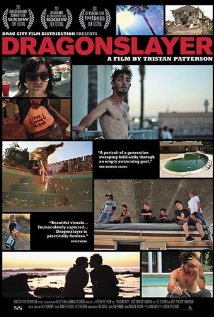 Review Fix continues their chat with “Dragonslayer” Director Tristan Patterson, who discusses the editing process and what it was like to work so closely with pro skateboarding legend Josh “Skreech†Sandoval on the project.
Review Fix continues their chat with “Dragonslayer” Director Tristan Patterson, who discusses the editing process and what it was like to work so closely with pro skateboarding legend Josh “Skreech†Sandoval on the project.
A Grand Jury Prize Winner for Best Documentary at SXSW 2011, the film is a candid look at Sandoval’s life.
You can check out Review Fix’s review of the film, here.
For more info on the film, head to their official Facebook page, here.
Review Fix: How difficult was the film to edit? You have an incredibly talented Director of Photography [Eric Koretz] and a clear vision, but you mix in this almost archaic footage from Skreech.
Tristan Patterson: It’s funny because when we were filming, these things would happen where I would think I had these film references to draw upon, like what I said before about Skreech reminding me of a character from “Suburbia†or he reminds me of Linda Manz in “Out of the Blue.†Then I started seeing Leslie and I said, “ This girl reminds me of Jean Seberg in “Breathless,†so I had all of these film references that I thought could help me when we started editing. When the editing process began, all of that went out the window because I couldn’t say, “This movie feels like this,†so we’ll just edit it that way. I had to figure out a language for this film that was all its own. I think because we were going for this high-cinematic, verite-style; it almost plays more like a narrative movie.
We only had one take of everything. Everything was happening in real time. We didn’t have multiple camera angles or anything like that. So the editing process was trying to keep that style, but at the same time, be as authentic as we could to what we were filming. Strangely, our footage was much more difficult to edit than Skreech’s. He had a point and shoot camera and it was more rapid-fire of him taking in moments that were interesting and blasting them together. A lot of his footage would result in just one long shot. Sometimes his shots were messy and all over the place, but I love the way it works. We just had to craft it all together.
Review Fix: How difficult was it to shoot this film? During many times in the movie, Skreech is going through so much, from sleeping in tents, to battling injuries and a lack of food. How hard is it to just sit there and watch that?
Patterson: One of things I love about him is he’s a perennial optimist in a way. He doesn’t see the world in many ways that others might. He doesn’t judge or evaluate if he’s doing something good or bad. He’s being sincere when he’s sleeping in a tent in his friend’s backyard and jokes that he has to creep in during the morning and have some ramen noodles. He’s being sincere about that. That I think comes out of the punk culture that it’s a way of being that may not be for everybody, but I think, at least in the moment, worked for him. I think there’s a whole culture of kids out there living like that. He’s a bit different though. Because of the skateboarding, he’s been to Sweden, Japan. A lot of those kids have never left that Inland Empire, Orange County life. He has. He’s been all over the world. I think it’s all in the eye of the beholder.
Review Fix: Is there anything in the film that you would have liked to include, but didn’t?
Patterson: I’m sure there is. When shooting, there are always so many great things happening at once that you wish you could be everywhere at once. One example happened during the first day of shooting. Skreech broke into this burned-down Casino that he knew had a swimming pool. He cleaned the pool for an hour. Like, I mean really cleaned it. I was surprised how clean he got that thing, just to skate in it. I couldn’t believe it. He got to skate in it for about six minutes.
Suddenly, this old lady came out; we didn’t know anyone was living there. We thought that the casino had burned down and there was this house connected to it. It just seemed abandoned. The old lady came out screaming and in the movie, you see Skreech acting like “Okay, I guess we’re out of here; it’s cool.†As a filmmaker, I wanted to get the old lady’s release and I needed to talk her into thinking it was okay that we shot on her property and that we didn’t break in. I started talking to her and it came out that this casino, in the middle of nowhere, was a famous Hollywood retreat and that John Wayne would come there, hang out by the pool and fuck all the cocktail waitresses. It turned out that the woman was from the East coast and moved out to Hollywood to become a showgirl in the ‘40s.
This all happened in the first day of shooting and it made the film feel so much about the decline of the West and this idea that California used to be looked at as the future and instead it’s the home of these kids trying to make sense of the rubble. This woman had this old, glorious Hollywood history and that no place in the movie. It felt like everywhere we went, we encountered something like that.
Come back to the site shortly before the film opens on Nov. 4 for the last installment of the site’s official interview with Patterson.


Leave a Reply